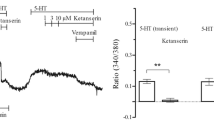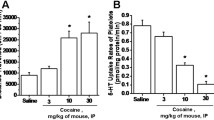Summary
Recent reports suggest that serotonin (5-HT)2 receptor-mediated second messenger systems are enhanced in platelets of affective disorders. To make the mechanism of the enhanced response clear, we investigated 5-HT2 and alpha (α)2-adrenergic receptor-induced intracellular calcium (Ca2+) mobilization in platelets of healthy volunteers, using fura-2. 5-HT2 and α2-adrenergic receptor-mediated Ca2+ mobilization was enhanced by prior exposure to the other type of agonist, so called “heterologous supersensitization”. The supersensitization was due to the enhancement of maximal response without change in agonist affinity. Chelating extracellular Ca2+ did not diminish the supersensitization. This enhancement of Ca2+ mobilization was not inhibited by H-7, an inhibitor of protein kinase C. However, this supersensitization was inhibited by pretreatment with sodium fluoride which directly activates guanine nucleotide binding regulatory proteins (G proteins). These results suggest that the supersensitization was caused from intracellular Ca2+ storage sites through a G protein-coupled pathway.
Similar content being viewed by others
Abbreviations
- fura-2/AM :
-
1-(2-(5“-carboxyoxazol-2”-yl)-6-aminobenzofuran-5-oxy)-2-(2′-amino-5′-methylphenoxy)-ethane-N,N,N′, N′-tetraacetic acid, pentaacetoxymethyl ester
- H-7 :
-
1-(5-isoquinolinesulfonyl)-2-methylpiperazine dihydrochloride
- EGTA :
-
ethylenedioxybis(ethylamine)-N,N,N′,N′-tetraacetic acid
- HEPES :
-
4-(2-hydroxyethyl)-1-piperazineethanesulfonic acid
- NaF :
-
sodium fluoride
- Fmax :
-
maximal fluorescence intensity
- Fmin :
-
minimal fluorescence intensity
References
Affolter H, Erne P, Burgisser E, Pletscher A (1984) Ca2+ as messenger of 5HT2-receptor stimulation in human blood platelets. Naunyn-Schmiedebergs Arch Pharmacol 325: 337–342
Aprison MH, Takahashi R, Tachiki K (1978) Hypersensitive serotonergic receptors involved in clinical depression — a theory. In: Haber B, Aprison MH (eds) Neuropharmacology and behavior. Plenum, New York, pp 23–53
Arora RC, Meltzer HY (1989) Increased serotonin2 (5-HT2) receptor binding as measured by3H-lysergic acid diethylamide (3H-LSD) in the blood platelets of depressed patients. Life Sci 44: 725–734
Biegon A, Weizman A, Karp L, Ram A, Tiano S, Wolff A (1987) Serotonin 5-HT2 receptor binding on blood platelets — A peripheral marker for depression? Life Sci 41: 2485–2492
Bigay J, Deterre P, Pfister C, Chabre M (1987) Fluoride complex of aluminium or beryllium act on G-proteins as reversibly bound analogues of the γ phosphate of GTP. EMBO J 6: 2907–2913
Cotecchia S, Kobilka BK, Daniel KW, Nolan RD, Lapetina EG, Caron MG, Lefkowitz RJ, Regan JW (1990) Multiple second messenger pathways of α-adrenergic receptor subtypes expressed in eukaryotic cells. J Biol Chem 265: 63–69
Crouch MF, Lapetina EG (1988) The Na+/H+ antiporter is not involved in potentiation of thrombin-induced responses by epinephrine. Biochem Biophys Res Commun 151: 178–186
de Chaffoy de Courcelles D, Leysen JE, De Clerk F, Van Belle H, Janssen PA (1985) Evidence that phospholipid turnover is the signal transducing system coupled to serotonin-S2 receptor sites. J Biol Chem 260: 7603–7608
de Chaffoy de Courcelles D, Roevens P, Van Belle H, De Clerk F (1987) The synergistic effect of serotonin and epinephrine on the human platelet at the level of signal transduction. FEBS Lett 219: 283–288
Diamant S, Atlas D (1989) Potentiation of [3H]inositol phosphate formation by receptor activation and membrane depolarization in brain cortical slices (I). Brain Res 503: 55–61
Fisher SK, Agranoff BW (1981) Enhancement of the muscarinic synaptosomal phospholipid labeling effect by the ionophore A-23187. J Neurochem 37: 968–977
Garcia-Sevilla JA, Udina C, Fuster MJ, Alvarez E, Casas M (1987) Enhanced binding of [3H](-)adrenaline to platelets of depressed patients with melancholia: effect of longterm clomipramine treatment. Acta Psychiatr Scand 75: 150–157
Grynkiewicz G, Poenie M, Tsien RY (1985) A new generation of Ca2+ indicators with greatly improved fluorescence properties. J Biol Chem 260: 3440–3450
Kafka MS, Paul SM (1986) Platelet α2-adrenergic receptors in depression. Arch Gen Psychiatry 43: 91–95
Kahn RA (1991) Fluoride is not an activator of the smaller (20–25 kDa) GTP-binding proteins. J Biol Chem 266: 15595–15597
Kagaya A, Mikuni M, Kusumi I, Yamamoto H, Takahashi K (1990) Serotonin-induced acute desensitization of serotonin2 receptors in human platelets via a mechanism involving protein kinase C. J Pharmacol Exp Ther 255: 305–311
Katada T, Northup JK, Bokoch GM, Ui M, Gilman A (1984) The inhibitory guanine nucleotide-binding regulatory component of adenylate cyclase. Subunit dissociation and guanine nucleotide-dependent hormonal inhibition. J Biol Chem 259: 3578–3585
Kusumi I, Koyama T, Yamashita I (1991) Serotonin-stimulated Ca2+ a response is increased in the blood platelets of depressed patients. Biol Psychiatry 30: 310–312
Martin TFJ, Lucas DO, Bajjalieh SM, Kowalchyk JA (1986) Thyrotropin-releasing hormone activates a Ca2+-dependent polyphosphoinositide phosphodiesterase in permeable GH3 cells. J Biol Chem 261: 2918–2927
McFadzean I, Mullaney I, Brown DA, Milligan G (1989) Antibodies to GTP binding protein, Go, antagonize noradrenaline-induced calcium current inhibition in NG108-15 hybrid cells. Neuron 3: 177–182
Meltzer HY, Umberkoman-Witta B, Robertson A, Tricou BJ, Lowy M, Perline R (1984) Effect of 5-hydroxytryptophan on serum cortisol levels in major affective disorders. 1. Enhanced response in depression and mania. Arch Gen Psychiatry 41: 366–374
Michel MC, Brass LF, Williams A, Bokoch GM, LaMorte VJ, Motulsky HJ (1989) α2-Adrenergic receptor stimulation mobilized intracellular Ca2+ in human erythroleukemia cells. J Biol Chem 264: 4986–4991
Mikuni M, Kusumi I, Kagaya A, Kuroda Y, Mori H, Takahashi K (1991) Increased 5-HT-2 receptor function as measured by serotonin-stimulated phosphoinositide hydrolysis in platelets of depressed patients. Prog NeuroPsychopharmacol Biol Psychiatry 15: 49–61
Mikuni M, Kagaya A, Takahashi K, Meltzer HY (1992) Serotonin but not norepinephrine-induced calcium mobilization is enhanced in platelets of affective disorders. Psychopharmacology (in press)
Mitrius JC, Mikuni M, Arora RC, Meltzer HY, U'Prichard C (1983) Responsiveness of α2-adrenergic receptors is decreased in platelets from depressed patients. Soc Neurosci Abstr 9: 990
Mori H, Mikuni M, Koyama T, Yamashita I (1989) Epinephrine stimulates inositol phospholipid metabolism by activating alpha-2 adrenergic receptors in human platelets. Life Sci 44: 741–747
Pandey GN, Pandey SC, Janicak PG, Marks RC, Davis JM (1990) Platelet serotonin-2 receptor binding sites in depression and suicide. Biol Psychiatry 28: 215–222
Siess W, Lapetina EG (1989) Platelet aggregation induced by α2-adrenoceptor and protein kinase C activation. A novel synergism. Biochem J 263: 377–385
Smrcka AV, Hepler JR, Brown KO, Sternweis PC (1991) Regulation of polyphosphoinositide-specific phospholipase C activity by purified Gq. Science 251: 804–807
Steen VM, Tysnes OB, Holmsen H (1988) Synergism between thrombin and adrenaline (epinephrine) in human platelets. Biochem J 253: 581–586
Sweatt JD, Connolly TM, Cragoe EJ, Limbird LE (1986) Evidence that Na+/H+ exchange regulates receptor-mediated phospholipase A2 activation in human platelets. J Biol Chem 261: 8667–8673
Vallar L, Biden TJ, Wollheim CB (1987) Guanine nucleotides induce Ca2+-dependent insulin secretion from permeabilized RINm5F cells. J Biol Chem 262: 5049–5056
Watson SP, Lapetina EG (1985) 1,2-Diacylglycerol and phorbol ester inhibit agonist-induced formation of inositol phosphates in human platelets: possible implications for negative feedback regulation of inositol phospholipid hydrolysis. Proc Natl Acad Sci USA 82: 2623–2626
Wolf BA, Colca JR, McDaniel ML (1986) Calmodulin inhibits inositol trisphosphate-induced Ca2+ mobilization from the endoplasmic reticulum of islets. Biochem Biophys Res Commun 141: 418–425
Author information
Authors and Affiliations
Rights and permissions
About this article
Cite this article
Kagaya, A., Mikuni, M., Yamamoto, H. et al. Heterologous supersensitization between serotonin2 and alpha2-adrenergic receptor-mediated intracellular calcium mobilization in human platelets. J. Neural Transmission 88, 25–36 (1992). https://doi.org/10.1007/BF01245034
Received:
Accepted:
Issue Date:
DOI: https://doi.org/10.1007/BF01245034




